Inverness was the first depot in Scotland to receive any BR/Sulzer Type 2s. Nineteen would be delivered, all from Derby Works and were used alongside a number of BRCW Type 2's and English Electric Type 1's to oust steam from the Highlands.
When delivered this Scottish batch represented the first major design variant of the class. Following the decision to abandon the disc/lamp method of train identification the Inverness bound locomotives were the first to feature the redesigned cab front and roof, the latter featuring a housing to enclose the four digit alpa-numeric displays, whilst the cab front presented a slightly less cluttered appearance with the absence of the discs and lights.
They were also delivered from Derby Works with an external recess on the driver's cab side, to allow fitting of tablet catcher equipment at a later date.


The delivery of the nineteen Derby built Type 2s began with D5114 during the week of April 23rd, deliveries continued until September when D5132 reached Inverness. June was the busiest month for deliveries with D5119 - D5123 received.
During October the locomotives visited St Rollox Works, Glasgow for the fitting of the tablet catcher equipment.



Philip Wylie writes that two of show the two locomotives and a snowplough derailed on the Dunphail side of Dava during the winter of 1962/63. Philip remembers a news clip shown on ITV of the plough charging the drift, from the photo it appears the plough, and maybe the Class 26 has derailed. This may also have been the year when a Class 24 and four coaches became stranded for four days close to Forres whilst working an Inverness - Perth via Granton service.
Sandy Anderson of Inverness writes of how the heavy snows affected the Forres, Dunphail, Dava, Grantown, Boat of Garten, Aviemore line as possibly depicted in some of the views above. Since it was a Sunday the two London trains went south via the Dava line, with a plough driven by Inverness driver George Cooper becoming derailed at the summit of the Dava, this incident was covered by TV crews. The first London was held up at the Dava station and the second at Dunphail. The plough was rerailed by Sunday night and three trains proceeded to Grantown on Spey, a plough reversing back and a workmens train propelling followed by the plough. Sandy was fireman to Jock Glass and manned the workmens train. On the Monday or Tuesday we picked up a Digger on a low-loader from Forres, by this time the Londons had been removed. We spent most of the week digging out the cutting and a plough came from the Grantown end with two engines, when they hit the snow the glass protecting the emergency stop on the outside of one of the diesels broke and the lever pulled and the engines stopped! The plough was uncoupled and the engines reversed and pulled it out with a chain. In the meantime the workers tran was backed off a couple of miles and a flagman was stationed at the end of the block, it was cleared on the second attempt.
The first week of November saw D5117 transferred to Eastfield (65A), to be used for trials on the Edinburgh - Glasgow services. D5326 was sent to Inverness in exchange whilst these trials were taking place.
A month later, the week before Christmas, D5116 headed south, transferred to Polmadie (66A). D5329 & D5336 were transferred to Inverness at this time.


![]() 1961
1961
For the week ending April 15th D5117 moved to Leith (64H).
During June the adventuring D5116 & D5117 returned to Inverness, D5116 the week ending June 3rd & D5117 the week ending June 17th.



With the diesels settling in the outlook appeared grim for the steam sub-sheds at Helmsdale, Kyle of Lochalsh and Wick. The greater versatility of the diesels allowed them to take over the various shunting duties as part of their their regular diagrams. This soon led to the aforementioned sub-sheds losing their allocations and eventually closing completely. Elsewhere by September the Aberdeen - Inverness line was almost totally in the hands of diesels and the West Highland line would soon see its last regular steam locomotives with the arrival of the BRCW Class 27s.
![]() 1962
1962
The Perth re-signalling scheme, completed March 26-27, led to considerably less train re-marshalling/locomotive changing taking place there. More through running from Inverness to Glasgow/Edinburgh commenced, with Edinburgh now having three through diesel hauled services from Inverness, at
8.20am, 11.00am & 3.45pm.
On May 7 all remaining steam hauled passenger trains at Edinburgh Waverley changed to diesel traction.
Although all the Class 24s at Inverness had been built at Derby they would rarely return there for overhaul. The first choice for scheduled heavy repair was the former GNSR workshops at Inverurie, when this closed they were sent to the workshops at St Rollox, Glasgow. Noted at Inverurie in February was D5121.


The locomotive from the Aberfeldy branch returned to Perth each morning, from here it worked the 12.17 down service to Inverness via Forres, running just ahead of this working was the 12.05 direct service to Inverness. The crew working the 12.17 down service had worked the previous night's Up Royal Highlander, lodging in the Perth Railway Hostel before taking up the 12.17. The 12.17 was generally made up of a CK & BSK with a BG from Perth, on Tuesdays & Thursdays a Vanfit with yeast was added, whilst occasionally a Vanfit or Conflat for RAF Kinloss or RNAS Lossiemouth was attached.
These views, picked up on Ebay (the seller living in Lairg) were still in their original yellow Kodak sleeve, which on the reverse referenced 'Kodak, New Zealand', pictures seemingly almost as well travelled as the Class 26s.
(The Aberfeldy branch would lose its passenger service from May 3rd 1965.)
A reader who stopped by the site, Dave Walker wrote that he rode this branch as a child until the branch closed. Because the branch line working was normally one coach and the locomotive, Dave always remembers the sound of the diesel locomotive as it made its way up and down the branch. He remembers the coach was non-corridor and had the old style leather belt window openers. After the branch closed Dave had to ride buses to Perth, a poor substitute after the personality & charm of the Aberfeldy branch.
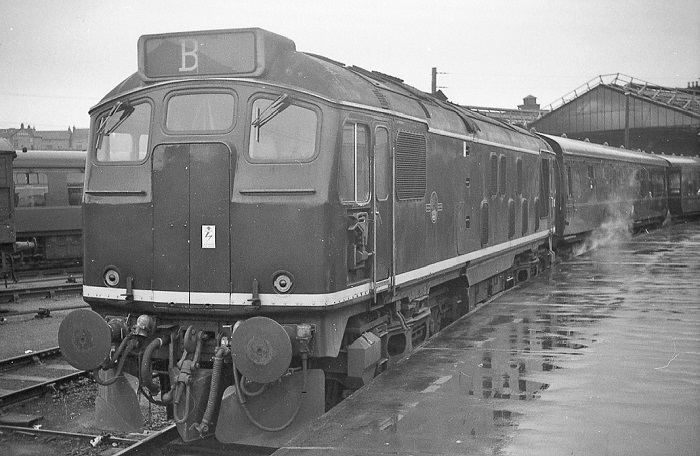
![]() 1963
1963

![]() 1964
1964

![]() 1965
1965
In January it was announced that many of the Type 2s operating from Inverness would be equipped with twin sealed beam headlights
On May 3rd the Aberfeldy branch closed, this released an Inverness Type 2 to be diagrammed for a late afternoon Glasgow - Dundee - Glasgow working.
The Inverness allocation as at October 30 was: 2413/22/23/24, 3735, 3896, 4095/96, 5114 - 5132, 5320 - 5346 & 8031 - 8034.
![]() 1966
1966
The wanderings of the Inverness Type 2s increased when the 20.25 Perth - Carlisle parcels was dieselised from March 2nd, on that first day D5119 was used, returning with the following morning's 06.10 Carlisle - Perth parcels.
![]() 1967
1967
Increased coal output from collieries in the Ayr region found D5116 borrowed for at least a week to assist with the extra movements.

On December 31st the Inverness allocation was: 2423, 3735, 4095/96, 5114 - 5132, 5316 - 5346.
![]() 1968
1968
For reasons unknown, perhaps due to diagramming changes the Inverness Type 2s started to appear on the Waverley route passenger workings.

On September 9th 5122 had been diagrammed to work an early morning passenger train from Perth to Glasgow Queen Street. On its return trip it left Queen Street just before 9am to work back light engine to Perth. Ahead of it was the 08.46 Glasgow - Edinburgh passenger dmu formed of a six car InterCity unit. On the approaches to Greenhill Upper Junction this train was brought to a halt under the protection of signals just short of the closed Castlecary station, due a train crossing over the junction ahead of them.
Following the diesel multiple unit was 5122 which was also brought to a halt whilst the conflicting movement ahead of them cleared. There had also been a track circuit failure at Upper Greenhill which was causing delays and led to the presence of several Signal & Telegraph staff in the area. Confusion with the train crews contacting the signalman over the delays to the stopped train led to the second man of the Class 24 acting on the instruction intended for the 08.46 unit. The instruction allowed for the passing of a signal at danger, but in doing so the driver of 5122 accelerated to a speed that was considered unsafe in light of there being a possible undetermined obstruction ahead.
The S & T staff had the misfortune to witness the sudden arrival of the Class 24 at the point where the 08.46 unit was still standing. Despite trying to attract the attention of the driver there was insufficient room to bring the locomotive to a halt. The impact took place at about 35mph with the locomotive embedding itself in the rear power car - SC79092. Shortly after the collision the 08.30 Edinburgh - Glasgow diesel multiple unit arrived on the scene, recognising the obstruction at the rear of the unit the driver made an emergency brake application but was not swift enough to prevent his train from striking some metal displaced from the locomotive, damage to the unit was insignificant. Unable to provide any assistance to the trains involved this train left the scene, shortly after which fire broke out engulfing the cab area of the locomotive and all of the power car. The leading five vehicles had by this time been detached.
For the locomotive the collision destroyed the No.2 (leading) cab and boiler room. The main frames were broken and distorted with the engine & boiler room bulkheads damaged. The whole of the driving controls, electrical wiring and fittings in the No 2 cab were destroyed. The leading bogie was derailed as was one set of wheels of the DMU's bogie. Regretably the locomotive driver and his assistant were killed instantly, whilst three passengers were injured on the unit.
Surprisingly the track sustained only minor damage, service over the line was re-established at 2.30pm that day. The damaged vehicles were moved to Bonnybridge, remaining there until September 24th, when movement took place to Eastfield. Withdrawal occurred in September, the locomotive reaching Glasgow Works by October. Possibly the transfer of 5318 to Inverness was effected to cover the loss of 5122.
On December 31st the Inverness allocation was: 2423, 3211, 3548, 3660, 3735, 3896, 4095, 5114 - 5121/5123 - 5132, 5320 - 5346.

![]() 1969
1969

On January 4th the Carlisle - Edinburgh 'Waverley' route closed, a route occasionally travelled by the Inverness allocated Type 2's.
The line to Kyle was blocked in early November by a landslide at Strathcarron, stranding 5125 and some coaches west of the blockage. Attempts to clear the line revealed a segment of unstable strata which eventually required the construction of a snowshed type structure. Enough of the line had been cleared by January 5th to allow 5125 to be gingerly shunted across a temporary length of track allowing it to return to its more normal duties. The line would not re-open until March 15 1970.
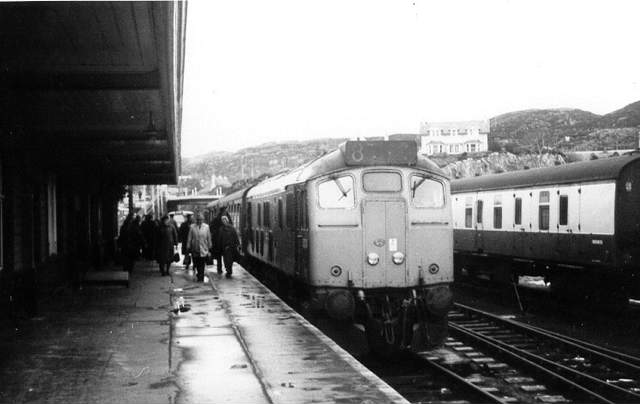
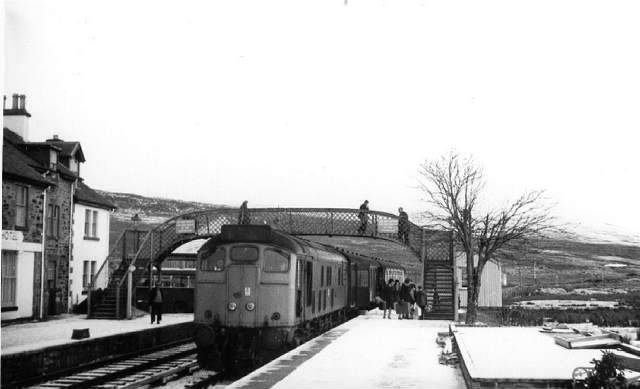
On December 31st the Inverness allocation was: 2423, 3211, 3548/51/55, 3660, 3735, 3896, 5114 - 5121/5123 - 5132, 5330 - 5346.
![]() 1970
1970
A look at some of the locomotive diagrams north of Inverness:
Kyle of Lochalsh - Inverness 04.55 two coach boat train, loco returns with-
Inverness - Kyle of Lochalsh 10.30 passenger, loco returns with-
Kyle of Lochalsh - Inverness 17.50 passenger.
Inverness - Kyle of Lochalsh 05.32 goods, with two locos, which split on arrival
Kyle of Lochalsh - Inverness 11.08 passenger (first locomotive) returns with-
Inverness - Kyle of Lochalsh 17.40 passenger.
Kyle of Lochalsh - Inverness 13.40 goods (second locomotive)
In the Far North three locomotives stable overnight, two at Wick and one at Thurso.
One locomotive from Wick & Thurso each work the first passenger train of the day:
Wick - Inverness 05.13 &
Thurso - Georgemas Junction 05.15 where the train combines and the Thurso locomotive is removed.
The second Wick locomotive works the 05.59 Wick - Georgemas Junction goods, at Georgemas this train is taken over by the
ex-Thurso passenger locomotive which then works the goods train through to Inverness, returning with the Inverness - Wick 17.00 passenger.
The second Wick locomotive eventually ends its day at Thurso.
Inverness - Wick 06.42 goods, waiting overnight at Wick to handle the next day's goods working.
Inverness - Wick 10.50 passenger, returns with-
Wick - Inverness 17.20 passenger.
Inverness - Lairg 08.23 goods.
Inverness - Invergordon 09.17 goods.
Inverness - Invergordon 11.15 goods.
On December 31st the Inverness allocation was: 2423, 3551/55, 3660, 3735, 3896, 5114 - 5121/5123 - 5132, 5330 - 5346.

![]() 1971
1971
At the end of May the Inverness harbour job was converted to a Class 08 working. This released Inverness's solitary Class 06 for further duties, this time at Aberdeen (61B).
Another recorded diagram change involved the closure of the signing-on point at Elgin effective August 23rd. The Class 08 shunter stationed here returned to Inverness, the locomotive working the afternoon Craiginches - Keith would run light to Elgin and handle any shunting. The Inverness - Keith 17.00 goods additionally worked trips to Aberlour & Elgin. This locomotive would combine with that off the Craiginches - Keith 14.00 goods and then work the Elgin - Aberdeen, Guild Street 17.28 goods.
A collision at Inverness depot between 5131 & 6855 led to considerable damage to both locomotives, eventually leading to the withdrawal of 5131 during September. By October 5131 had reached Glasgow Works.
A visit to Glasgow Works during November found that the remains of 5122 (withdrawn September 1968) had finally been disposed of whilst the undamaged cab from 5131 had been transplanted on to 5115.
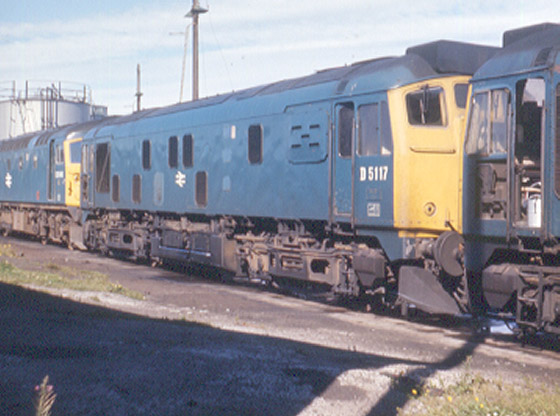
A view from August 1971 finds 5117 awaiting its next turn of duty at Inverness depot. Three years after steam has finished it still carries its 'D' prefix, and carries all its Inverness regalia - headlights, tablet catchers, unique boiler room blanking plates and snowploughs.
On December 31st the Inverness allocation was: 3551/55, 3660, 3735/87, 3896, 5114 - 5121/5123 - 5130/5132, 5330 - 5346.
![]() 1972
1972
A new arrival at Inverness during April was 5113. This locomotive differed from the other Class 24s here because it did not carry the roof mounted headcode box, being the last Class 24 built in the lamp/disc style.

A new working for Inverness was the temporary flow of North Sea pipes from Invergordon (recieved by ship from Japan) to Gateshead. Here they underwent a special treatment, then returned to Invergordon. The inaugural working was by a pair of Class 24's. This working ceased once a special treatment plant was constructed at Invergordon.
5114 was retired during October.


![]() 1973
1973
By February 5114 had finally reached Glasgow Works for stripping & eventual scrapping.
5101 was transferred during February to Inverness, but immediately returned to Eastfield, presumably the physical transfer never took place. However 5329 did move to Inverness that same month as did 5327 during April.
The slow dismemberment of 5114 continued at Glasgow, by August both cabs were missing, reportedly shipped down to Derby Works and used on 5055.
After a stay of eighteen months 5113 was transferred back to Eastfield.
A sign of the times to come was the transfer of 47516 from Haymarket to Inverness on December 2, the 08.45 Edinburgh - Inverness being used to effect the transfer. Initially used for driver training it was also regularly found working the overnight Milburn - Millerhill as far as Perth, returning on a northbound parcels. It was also to be found on the 'Royal Highlander' & 'Clansman' passenger workings.
![]() 1974
1974
5112 & 5113 were transferred from Eastfield to Inverness during February.
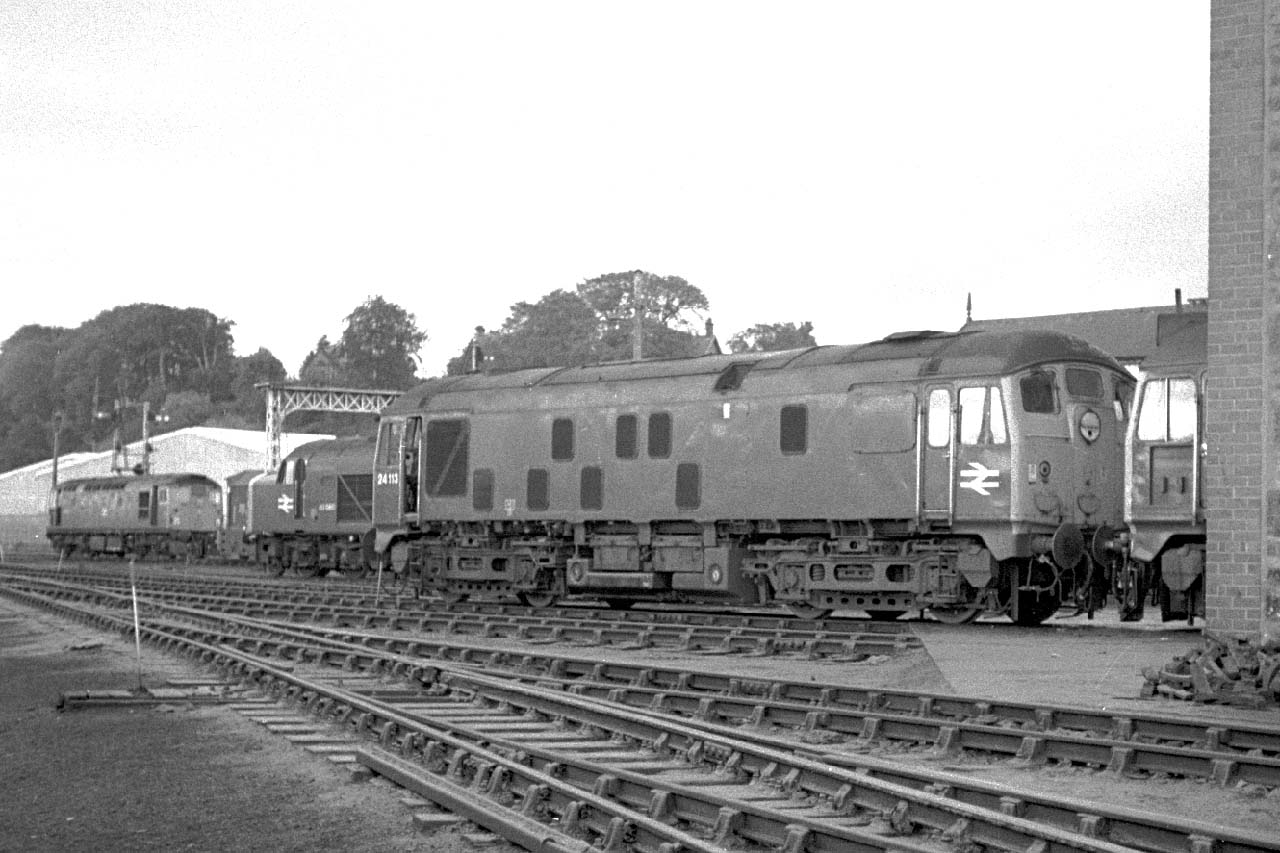
24102, 24103, 24104 were transferred from Eastfield to Inverness during May. With the new timetables came an increase of Type 4 workings over the Highland line, with eight services north of Perth now in the hands of Classes 40 & 47. To some extent this had been made possible by the recent transfer of thirty six diesels from England to Scotland.
47516 returned to Haymarket in June.
24111 moved to Inverness during December. As the year closed out more Type 4's were drafted in to oust the paired Type 2's on the Highland line. The displaced Type 2's were found in charge of many freights.


![]() 1975
1975
24111 returned to Eastfield during March.
24110 moved to Inverness in May. Class 40's were now very prominent on the Inverness - Edinburgh/Glasgow passenger workings.
South of the border brought major upheavels for the Class 24 fleet with many stored/withdrawn. During August all of Eastfield's Class 24's were stored, the only Inverness locomotive stored was 24104. However all the Inverness allocated Class 24's had their sealed beam headlights removed and possibly their boilers isolated. A number of Class 26's had headlights fitted at this time. Time was now short for the original Inverness fleet, three had already been withdrawn, and after fifteen years service and with a continuing surplus of locomotives it was no surprise to find that between September and November all the Inverness Class 24's either moved to Haymarket or were put to store.
September: 24120, 24121, 24123, 24125, 24126, 24128 to Haymarket
October: 24102, 24103, 24132 to store; 24113, 24115, 24116, 24118 to Haymarket.
November: 24125 to store; 24117, 24119, 24124, 24127, 24129, 24130 to Haymarket.
With this batch of transfers Inverness said farewell to its allocation of Class 24's, for all apart from 24116 & 24117 this was their first transfer. However with the locomotives now based at Haymarket they were still regularly diagrammed for passenger workings to Inverness and could be frequently seen over the Highland mainline at least until October 1976.
To cover the loss of these machines nine Class 26's were transferred in from Haymarket whilst Inverness received its first allocation of Class 25's: 25030, 25031, 25092, 25093, 25096.
On November 12 a Glasgow Queen St. - Oban service was handled by 24117. This line was no stranger to the Class 24's, though it was normally those from Eastfield depot that would be seen on this line.
![]() 1976
1976
A somewhat out of the ordinairy trip was had by 24121 on April 6 whilst working the 15.35 Inverness - Edinburgh with 26034. After the Class 26 failed at Kingussie 25029 was used to assist. However it was reported that parts had been seen falling off the Class 25, this was removed leaving 24121
to soldier on alone, arriving two hours late!
During May 25030, 25031, 25092, 25093, 25096 were all transferred back to Eastfield leaving only Classes 08 & 26 on allocation at Inverness.
The absence of Class 25's was brief, during June 25062, 25064, 25083 were transferred to Inverness. 25092 & 25093 also returned to Inverness in July, but were quickly returned to Eastfield by month end.
A return to earlier times occurred when 24129 & 24130 worked the 12.15 Inverness - Glasgow on August 11. The previous day 40123 had failed at Dalwhinnie whilst working the 09.35 Glasgow/Edinburgh - Inverness. 24112 arrived to rescue the train, with 26009 added at Aviemore.
As well as forays on the Highland mainline the former Inverness Class 24's were frequently turned out for other passenger workings. The infamous 1E83 Edinburgh - Berwick was well known for its variety of locomotives rostered, Class 24's were no exception, 24115 being noted on September 15. Likewise the Edinburgh - Aberdeen services occasionally featured the Class 24's. On September 17 24115 & 24120 worked the 07.40 Aberdeen - Edinburgh, whilst on September 30 24120 & 24104 handled the 12.30 Aberdeen - Edinburgh.
The end of the summer timetable brought a deathknell to the remaining ex-Inverness Class 24's, with the few remaining examples stored by October, though official withdrawal did not occur until December. The only remaining operational Class 24's were now allocated to Crewe.
On December 31st the Inverness allocation was: 08568/620/728/855, 25062/64/83, 26008 - 15/17 - 19/21 - 46.
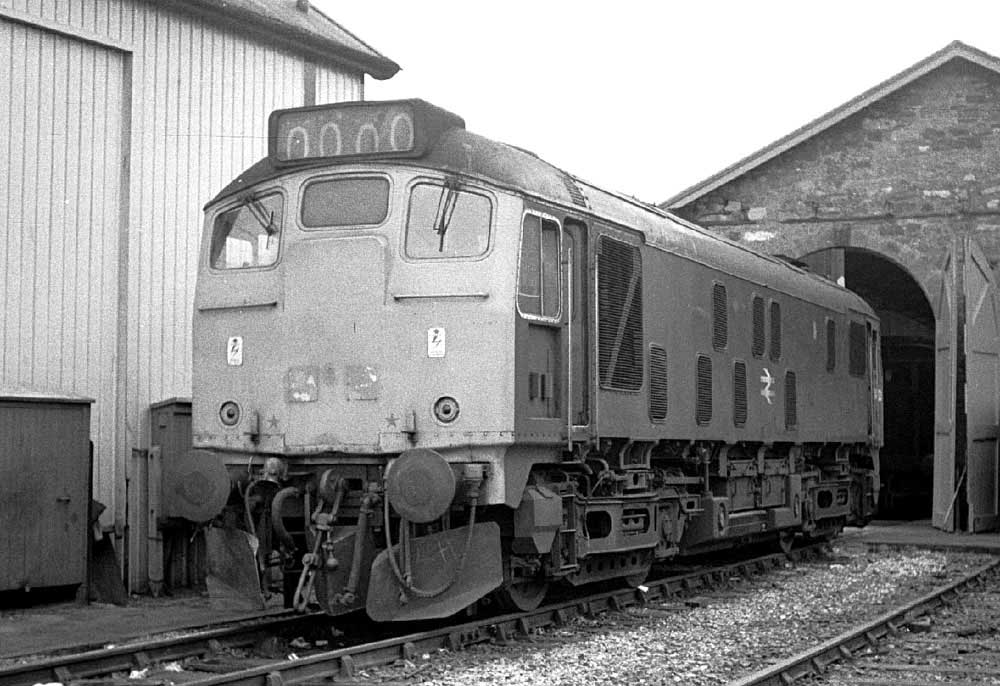
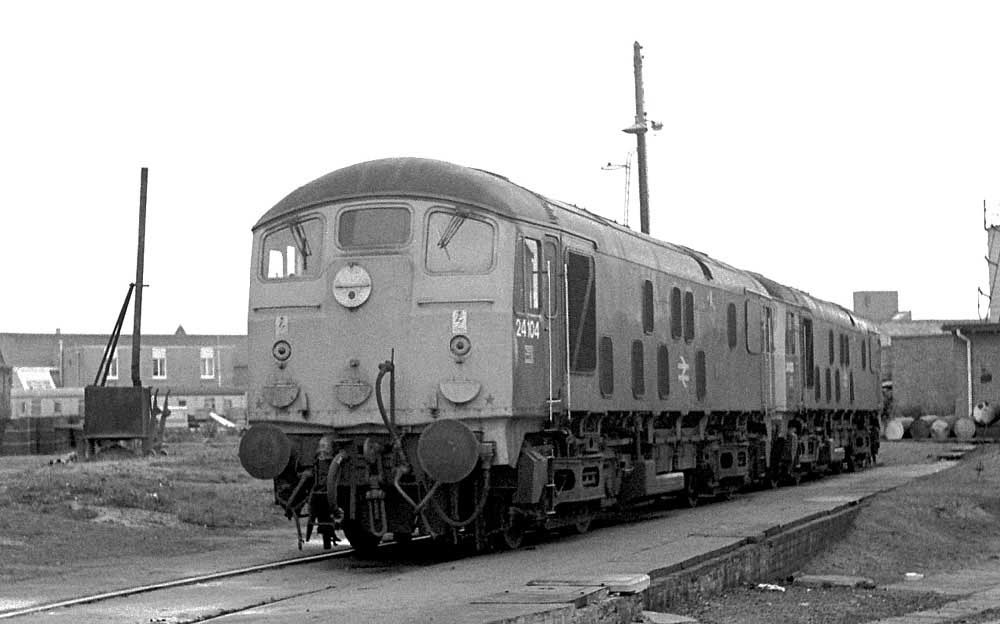
![]() 1977
1977
With the introduction of the May timetable the following Class 25's were added to the Inverness fleet : 25068, 25226/228/229/231/233/234/238.
On December 31st the Inverness allocation was: 08568/620/728/738, 25062/64/68/83, 25226/228/229/231/233/234/238, 26008/10 - 15/18/19/21 - 46.
![]() 1978
1978
Again the May timetable changes saw an alteration to the Class 25 fleet at Inverness. This time 25083, 25226/228/229/231/233/234/238 were transferred to Eastfield, leaving just 25062/64/68 at Inverness. The loss of the Class 25's was perhaps made good in the transfer of six
ETH equipped Class 47's to Inverness.
Late in December 25064 was sent to Eastfield in exchange for 25066
On December 31st the Inverness allocation was: 08568/620/728/738, 25062/66/68, 26013/14/15/18/19/21 - 46, 47464/465/469/472, 47546/550.
![]() 1979
1979
During June 25062/66/68 were sent to Eastfield in exchange for 20007/20/85. This left Inverness without any Class 25 on allocation. There would be no further Class 25 allocations at Inverness, although examples from other depots, particularly Eastfield could still be found visiting the Highland capital.
![]()
| The final fate of the remaining original Inverness allocation (24115 - 24121, 24123 - 24130, 24132) | ||||||||||||||||||||||||||||||||||||||||||||||||||||||||||||||||||||||||||||||||||||||||||||||||||||||
| Loco: | To Haymarket: | Stored: | Withdrawn: | Despatched to: | Broken up by: |
| 24115 | Oct 75 | Oct 76 | Dec 76 | Swindon May 77 | June 77 | 24116 | Oct 75 | Sept 76 | Sept 76 | Doncaster Mar 77 | July 77 | 24117 | Nov 75 | Dec 75 | Feb 76 | Doncaster May 76 | Jan 77 | 24118 | Oct 75 | Oct 76 | Dec 76 | Doncaster ?/77 | June 77 | 24119 | Nov 75 | Apr 76 | July 76 | Doncaster ?/77 | May 77 | 24120 | Sept 75 | Oct 76 | Dec 76 | Doncaster Jun 77 | Aug 77 | 24121 | Sept 75 | Oct 76 | Dec 76 | Doncaster Feb 78 | May 78 | 24123 | Sept 75 | June 76 | July 76 | Doncaster Mar 77 | July 77 | 24124 | Nov 75 | July 76 | Nov 76 | Swindon May 77 | May 77 | 24125 | Sept 75 | Nov 75 | Mar 76 | Doncaster ?/76 | July 77 | 24126 | Sept 75 | Dec 75 | Feb 76 | Doncaster ?/76 | July 77 | 24127 | Nov 75 | Dec 75 | Feb 76 | Doncaster ?/76 | Mar 77 | 24128 | Sept 75 | May 76 | July 76 | Doncaster ?/77 | Oct 77 | 24129 | Nov 75 | Oct 76 | Dec 76 | Doncaster ?/77 | April 77 | 24130 | Nov 75 | Oct 76 | Nov 76 | Doncaster Jun 77 | Aug 77 | 24132 | N/A | Oct 75 | Feb 76 | Doncaster Feb 76 | Mar 76 |
Final Journies
24132 ? - Doncaster February 6 1976
24015/16/71, 24117 Glasgow Works - Doncaster May 3 1976, (behind 26046 at Berwick).
24103/16/23 & 08426 9F45 Polmadie - Doncaster March 17th 1977
24065, 24107/15/24 02.20 Millerhill-Derby-Gloucester-Swindon May 4th 1977
24069/94, 24120/30 Millerhill - Doncaster w/e June 18 1977
24019/66, 24102/121 07.00 Carlisle - Doncaster 9Z14 February 14 1978.

![]()
Minor Surgery for a Class 26
A reminiscence of a trip to Kyle of Lochalsh
From the keyboard of Mark Bennett
On December 2nd 1983 our scribe set out on a weekend trip from Derby to Kyle of Lochalsh, using a BR free pass, to obtain some Class 26 mileage. Extra points need to be given to Mr B for attempting this in deepest mid-winter, probably hatched from plans thought up in a dimly lit, smoke filled Derby hostelry.
As with any exits from Derby a Class 45 is recommended, in this case 45102 on the short hop to Birmingham New Street, followed by some fine use of 85011 on the 1S87 18.00 Birmingham - Glasgow. A dash across to Queen Street finds 47519 at the head of the 1N05 23.30 to Inverness, departure being assisted by 37051 banking. Beyond Perth its up to 47412 to handle the run over the Highland main line.
Now its December 3rd and 26043 is in charge of the 2K02 06.55 Inverness - Kyle of Lochalsh. From here Mr B takes up the story...........
"The line from Inverness to Kyle is not notable for locos being on full power but the stately progress and spectacular scenery more than make up for this. 26043 burbled along quite sweetly and arrived at Kyle on time, there being plenty of turn round time in the timetable.
Before going off for some liquid refreshment I waited to watch and photograph 26043 whilst it ran round its three coaches. The loco moved away towards the buffer stops and cleared the points. For some reason the loco kept shutting down when attempts were made to run it past the coaches, all was clearly not well! It would move, but only in one direction, towards the buffer stops, beyond which was Kyle harbour!
I approached the driver who was, by now, on his way to phone Inverness, making myself known (the usual Derby Loco Works, anything I can do trick). We both returned to 26043, upon entering the engine room it resembled a scaled down Class 45, particularly the electrical equipment (both Crompton Parkinson), so at least I had some idea where everything was. The first job was to remove the electrical control cubicle doors in order to observe what the contactors were up to (or not, as the case may be!). The driver started the loco, then with the straight air brake full on, a slight power application was applied. All the motor contacts made, situation normal - although still in the direction of the harbour! 'Right mate, power off and put her in the other gear and try it'. The reverser threw over normally, but when power was applied the engine shut down straight away. I soon discovered that the engine stop contact was energising instead of the power control relay, and proved when the loco did actually power as the 'PC' contact would energise.

The water temperature and oil pressure readings seemed OK, also there was sufficient oil on the rather huge dipstick. I hit on the idea of wedging the 'ES' relay to see what would happen, based on the 'it only goes bang once' theory and also in the light that a rescue loco had been despatched by Inverness, although it wouldn't arrive for another couple of hours at least. A phone call was made to Inverness depot to tell them of my plans, they suggested putting plastic tape on the contacts. I persuaded them otherwise as there was the risk that the sharp edges of the contacts might pierce the tape, causing the engine to shut down. Eventually they agreed to the wedging idea. The trial wedge consisted of a number of lollipop sticks. They were slid in one by one until the contact arm would not move. The driver then started 26043 and tried it first in the forward direction, towards the buffer stops. However he jumped out of the seat when it came to trying it in the other direction, 'I'm no trying it that way pal, you do it'. With a feeling of great dread I sat in the seat, put the reverser handle over to 'forward' and applied power, fully expecting a loud bang. What a joyous sight when the ammeter sailed round and we moved off, in the intended direction.
At this point I went off to manufacture a more permanent wedge which would not fall out when we were on the move. By this time the unusual events happening to the loco had circulated around the seventy passengers awaiting departure, it did not go un-noticed that a fellow tourist was repairing the loco. Now suitably armed with various different sizes of little wooden blocks I returned to 26043 which was, by now, attached to the relevent end of the train and ready for departure. Since the driver declared that the engine could not now be shut down from the stop button (the stop relay being isolated) it was necessary to isolate the batteries prior to departure. The faithful lollipop sticks were removed, with one of the more substantial wooden wedges hammered into place.
And so off we set, I rode in the back cab, departure was a mere fifteen minutes late to a round of applause from the passengers and station staff. At Strathcarron we met 26041 being driven by a relative of the driver of 26043. No time was wasted in pairing up the locos. The multi working was not connected though. 26043 was shut down so the wedge could be removed, then re-started and left idling so that the steam heating boiler could operate. And so 26041 powered us on our way to Inverness.
On arrival a bowler hatted gentleman was waiting, a hasty withdrawal was made from the cab of 26043, quickly assuming 'member of the public mode', not wanting a roasting from officialdom for being in the cab without a permit. However the driver spotted me and introduced me to the gentleman, the big boss of Inverness. He shook my hand and thanked me for what I had done, which had allowed a number of passengers to connect with the Euston service. Then followed a short walk with the driver to the Staff Association club for some beers!!!"
Although our story ends here, Mr B's journey continued on the 1G18 16.30 Inverness - Edinburgh as far as Perth behind 47519. The leg to Glasgow Queen Street utilised the 2T51 Perth - Glasgow behind 27048. 86219 did the honours on the 1V61 23.55 Glasgow Central - Bristol as far as Birmingham. 45124 was on the 1E75 08.10 Birmingham - York to finish the trip off at Derby on the morning of December 4th.
![]()
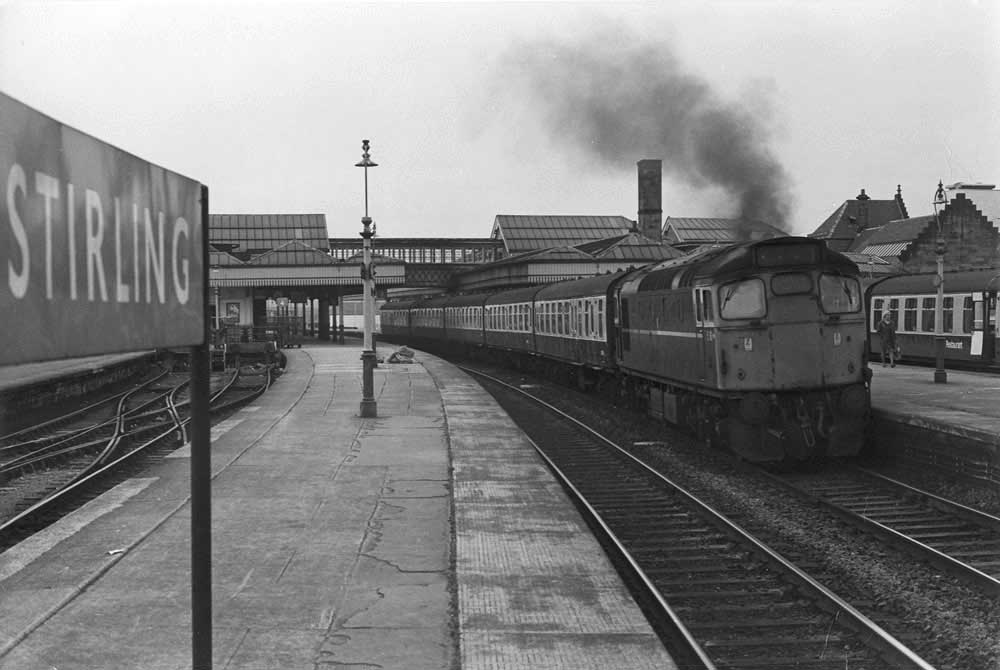

My Trips to Inverness
Notes from my Spotting Books
From the keyboard of your webmaster
My full time employment was not with British Rail and since overnight excursions from the East Midlands did not reach Inverness (the nearest being Aberdeen), it would require a considerable outlay to reach Inverness and this did not happen until September 1976.

The new order cometh, well not quite, just a lick of new paint and some fancy embloms finds 47120 at Inverness on June 10th 1985. Although very common over the Highland mainline the Class 47's would also spend some time on the Inverness - Aberdeen service and one at least is reported to have reached Kyle of Lochalsh on an excursion.
September 26th 1976
Numerous visits had been made to the Edinburgh & Glasgow area prior to September 25th 1976, with Haymarket, Polmadie & Eastfield always turning out a good showing of the Class 24's. However the aforementioned date was set for a weekend visit to Inverness, my first to the Highland capital. With vast chunks of cash handed over to the man behind the ticket window at Derby it was with a fair amount of trepidation that I boarded a Birmingham - York service, hauled by a trusty 45050. Now in all fairness to Saltley and their allocation of motive power, it might have been wiser to have turned out Noah's Ark for this whole trip, because it never stopped raining. A soggy York was reached where a Kings Cross - Edinburgh service hauled by 47552 wended its wet way to Edinburgh. What rain that wasn't falling in England appeared to have selected Edinburgh for unleashing. Deciding that Haymarket depot wasn't worth drowning for, accomodation was found and the wet remants of the day were spent around Waverley.
Hope springs eternal and the arrival of a new day, Sunday, brought the promise of my first run along the Highland mainline to Inverness. Of course it was still raining, it had to be. Waverley glistened, as did 40086 diagrammed for the journey via Perth. Haymarket produced a number of Class 24's - 24094, 24119/124/129, by this time most were in store, though 24129 was seen to be running. A shunting manouevre at Perth required the use of 08276, where it was still raining.
The Highland mainline was as majestic as ever, still raining, but enlightened by the knowledge that this was necessary for the production of a well known Scottish beverage. The Class 40 on the front end did its job and arrival at Inverness was more or less on time. Permission was granted for a visit round the depot, what else could one do in Inverness on a wet Sunday afternoon? Despite this being the twilight hours for the Class 24's and their northern visits were becoming rarer, the depot revealed a glistening 24112 parked behind the fuelling shack. After the required photographs, not easy in the failing overcast afternoon light, the other locomotives on the depot were noted, surprisingly a great variety - Classes 08/24-27/40/47 as well as a number of DMU's. It was left for 40072 to work its magic back south to Edinburgh, as the rain beat down on the hotel that night thoughts were of Highland Sulzers from days gone by.

Monday proved as soggy as ever, so a trip was made to Glasgow using 27203 & 27209, returning with 27112 & 27210. As the overcast skies were still delivering the wet stuff the trudge to Polmadie & Eastfield was forgotten. Glasgow Queen Street did turn up a very tired looking 27015, as it turned out this Class 27 was soon to be withdrawn, fortunately it was captured on film. Back at Waverley and with the sunshine as far away as ever 47528 was selected for a run south on the ECML. A few miles closer to the equator did not help, Newcastle proved if it was raining in Edinburgh, then it would rain harder at Newcastle, and it did! After persevering for a couple of hours watching 03170 shunt rain soaked parcels vehicles amidst the ever busy DMU's the arrival of 45073 on a service to Bristol marked the last leg of this adventure. Comfortably ensconced in the leading Mk2 with the rain running horizontal across the windows, it was left for this mighty fine Sulzer to plough its way south-west and home to Derby.
June 28th 1977
The next visit to Inverness was by car, as part of a grand camping tour of Scotland, the campsite for Inverness being situated at Bunchrew, just a few miles north of the Highland capital. By this time a Class 24 had not worked in Scotland for over six months, but a visit to Inverness depot on the afternoon of June 28th found the ever present Class 25/26/40/47's on hand.
Scotland did still hold on to a few withdrawn Class 24's, on this trip 24009, 24128/147 were at Carstairs, 24121 was at Polmadie, 24006 at Eastfield, 24106 at Millerhill, with over a dozen still parked at Carlisle Kingmoor. No Scottish Class 24s would reach preservation.




June 20th - 22nd 1978
Almost a year would pass before a return visit was made to Inverness, again on the annual camping extravaganza. Having arrived from Aberdeen on June 20th and pitched tent at Bunchrew, the next day saw the morning train to Wick/Thurso being taken for a day out in the Far North. 26046 did the honours to Georgemas, where 26043 took over for the run down to Thurso. The return trip south was in the hands of 26026 & 26034. A visit to the depot revealed the expected Class 25/26's, though the Class 40's were not so evident this time round.
The only Class 24 remaining in Scotland was Eastfield's resident wreck 24006.

April 27th - 29th 1979
The next soiree to Inverness was part of a weekend marathon, the Wirral Railway Circle's 'Orcadian' from Liverpool to the Orkneys. 47274 did the honours to Edinburgh, 47038 to Inverness, where 26021 & 26022 took over for the run to Wick/Thurso and back. Bad weather caused the cancellation of the sea portion of the trip, but rapid substitutions were made, which led to haulage from 26033 over the Thurso branch.
Inverness depot seemed leaner in terms of locomotives noted, mostly Class 26s, though more Class 47's were evident and a wandering 37098. South of Inverness 47038 did its thing via Aberdeen, 47020 backed on at Edinburgh but promptly failed. Haymarket turned out 40086, which was still going strong after we left the train at Manchester Victoria.

June 1st - 3rd 1979
Being a card carrying member of the 'Midland Railfans Club' meant there was no question of not joining their first venture in chartering a train, 'The Mid-Kylesman' to Inverness & Kyle of Lochalsh. 40012 did its job from Derby to Carlisle, 85020 to Mossend then 20039 & 20149 to Inverness. The trip included an early morning visit to the depot, which provided a fine array of Classes 08/25/26/37/40/47. The weather on this trip was warm & sunny all the way. 26022 & 26024 were called upon to take us on to Kyle of Lochalsh where a serious dent was made in the town's supply of ice cream & iced lollies.
After returning to Inverness 20039 & 20149 were waiting to head south, and as usual we went via Aberdeen. 86011 took over at Mossend, replaced at Carlisle by 47475, which wandered over to Newcastle before picking up the regular NE/SW trail, though with a few Sunday diversions thrown in for good measure.

June 6th - 8th 1980
Having had so much fun on the previous 'Orcadian' it was only natural to book on 1980's tour and so take us on our next visit to Inverness. 47131 did the honours to Edinburgh, where 47273 took us over the Highland mainline to Inverness. Awaiting here were 26015 & 26030 for the trek to Wick/Thurso. Inverness depot provided a good selection of Classes 08/20/25-27/40/47. Assisting over the Thurso branch was 26038.
Better weather this year allowed for the sailing portion of the tour to take place. The less said about this the better, yours truly doesn't sail well! Despite the northern latitude and the proximity to mid-summer the return journey was covered by either darkness or sleep, but 47273 returned us to Edinburgh and 47131 onward to Manchester.
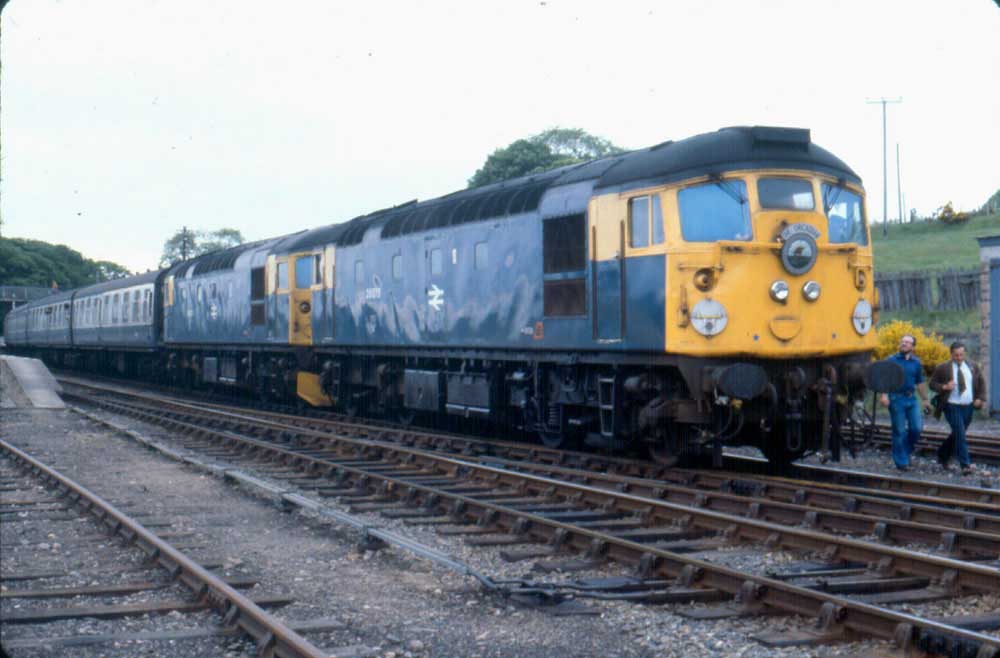

July 1st - 2nd 1980
Another camping trip to Scotland, visiting the same campsite at Bunchrew. More time was spent on photographing the Class 26 services, though the dull weather presented challenges. A couple of Class 27's were covered on the Inverness - Aberdeen services and a visit to Inverness depot on July 2nd found a good mix of Class 26/27 with 37/47's thrown in, though no Class 40's were present.




June 22nd - 23th 1981
As part of a tour of Scotland with a recently married bride an overnight stop was made at Inverness. The notebook doesn't reveal much of the trip, but Class 26/27's still filled the page at Inverness.


June 9th - 12th 1985
A holiday trip to the UK included a tour to old haunts in Scotland. Renting accomodation at Cawdor allowed frequent visits to Inverness and the line to Aberdeen at Nairn. Still the Class 26's were soldiering on, as were the Class 27's, those at Inverness were frequently the former Edinburgh & Glasgow machines now renumbered. Class 37/47's were also common.
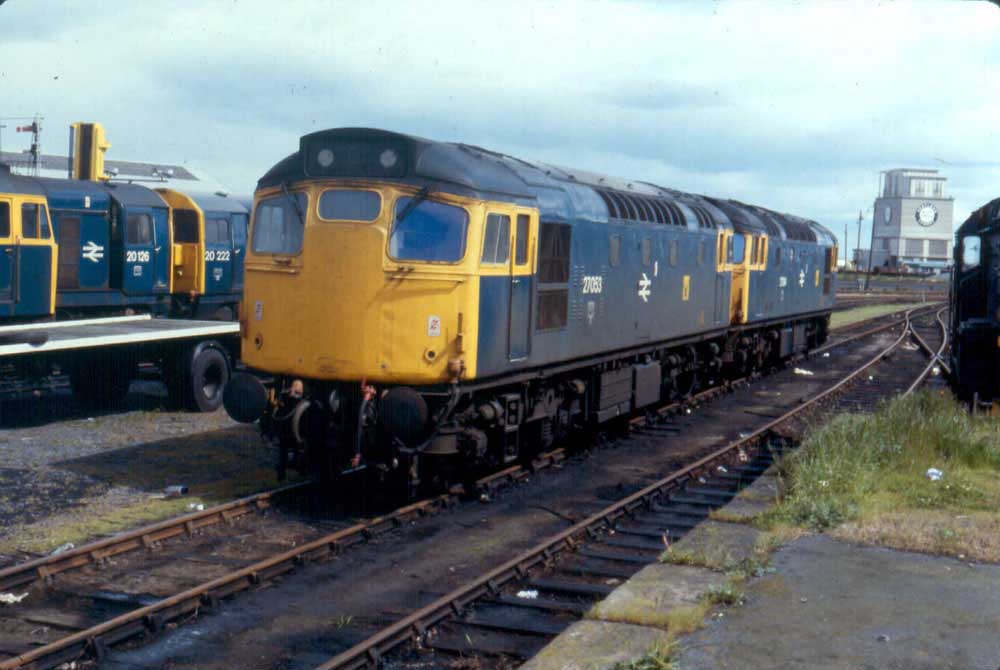
Further trips have been made to the UK since 1985, but with the transition of the Far North services to Class 37s and then to multiple units, for yours truly things are just not the same. That passenger or freight trains still run to Wick/Thurso & Kyle is truly awesome, but somehow without that Sulzer six cylinder engine churning out its distinctive sound................
![]()
Final condition of withdrawn locomotives with regard to detail differences/changes
If details matter, or if you are a modeller
Renumbering: All received TOPS renumbering except 5114, 5122 & 5131.
Blue livery: All carried blue livery with full yellow ends except 5122.
Headlights & Tablet Catchers: All carried the twin sealed beam headlights and tablet catcher apparatus at some point.
Fuel & water tanks: 5114-5120 original sized water tank, shortened fuel tank; 5121-5132 smaller water tank than 5114-5120 but same sized fuel tank.
Headlight cover plates:
Square: 24117, 24119, 24120, 24121, 24123, 24124, 24125, 24126, 24129, 24130;
Circular: 24116, 24118
Roof level water filler sheeted over (Modification started prior to 1968):
Yes: 5114, 24116, 24117, 24118, 24119, 24120, 24121, 24123, 24124, 24125, 24126, 24127, 24128, 24129;
No: 5122, 24130, 24132
Fuel and water tank gauges:
Both: 24116, 24117, 24120, 24121, 24123, 24124, 24125, 24128, 24129;
Fuel Tank only: 24118, 24126, 24127, 24130, 24132;
Neither: 5114, 5122, 24119
Weatherised headcode panel:
Yes: 24116, 24117, 24118, 24120, 24121, 24124, 24125, 24126, 24128, 24129, 24132;
No: 24119, 24123, 24127, 24130
Boiler room grille valencing:
Five cut outs: 5114, 5122, 24116, 24117, 24118, 24119, 24121, 24125, 24126, 24130;
Four cut outs: 24127;
Solid plate: 24120, 24124, 24128, 24129;
Grille: 24123
Sandbox type:
Ridged: 5122, 24116, 24118, 24120, 24121, 24123, 24124, 24125, 24126, 24127, 24128, 24129, 24130, 24132;
Smooth: 24117, 24119
Bogie Footsteps:
Three rung: 5114, 5122, 24116, 24117, 24118, 24120, 24121, 24123, 24124, 24125, 24126, 24127, 24128, 24129, 24130, 24132:
Two rung: 24119
Battery isolating switch cover:
Standard: 24118, 24130;
Vertically hinged: 24119, 24120, 24126, 24127, 24128, 24129;
Modified headcode housing: 24127 'B' end only?
![]()
More views of Inverness based locomotives outside of the original Class 24 batch 5114 - 5132.


Page added ??
Last updated April 5th 2025